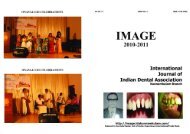hand book for dental surgeons - Indian Dental Association ...
hand book for dental surgeons - Indian Dental Association ...
hand book for dental surgeons - Indian Dental Association ...
Create successful ePaper yourself
Turn your PDF publications into a flip-book with our unique Google optimized e-Paper software.
26<br />
Visit: http://image.idakunnamkulam.com/<br />
Hand <strong>book</strong> <strong>for</strong> <strong>dental</strong> <strong>surgeons</strong> on <strong>dental</strong> management of persons with hemophilia and other haemostatic disorders<br />
Premedication of the hemophiliac is indicated when lengthy procedures are planned or when the patient is<br />
apprehensive or unruly. Preoperative plasma transfusion may be recommended if excessive bleeding is<br />
anticipated.<br />
As mentioned earlier, local anesthesia is usually contra indicated <strong>for</strong> a child with hemophilia. A general,<br />
anesthetic, administered by a trained anesthesiologist, who is cognizant of the bleeding problem, should be a<br />
relatively safe procedure <strong>for</strong> the hemophiliac patient.<br />
Be<strong>for</strong>e surgical treatment is attempted, all necessary restorative procedures should be completed with<br />
strict adherence to the precautionary measures already described. The extractions and other surgical treatment<br />
must be per<strong>for</strong>med with the least possible trauma. Use of pressure packs <strong>for</strong> the initial control of hemorrhage<br />
should be followed by packing the socket with Gelofoam or some other hemostatic agent that can be held in<br />
nplace by gauze impregnated with petrolatum to prevent the incorporation of the gauze in the blood clot.<br />
A follow-up transfusion schedule should be planned by the hematologist and the dentist. The duration<br />
of this therapy depends on the approximation of the healing time <strong>for</strong> the surgical wounds. the patient should<br />
receive nothing by mouth <strong>for</strong> 4 hours after the operation and should receive only liquids <strong>for</strong> the subsequent 24<br />
hours. The important of then patientís diet and postoperative home care must be carefully explained to his<br />
parents.<br />
NITROUS OXIDE ANALGESIA<br />
With the <strong>hand</strong>icapped child, inhalation analgesia with nitrous oxide can be a safe and effective method<br />
of decreasing apprehension or resistance to <strong>dental</strong> treatment. Except <strong>for</strong> children who have severe mental<br />
retardation or emotional disturbance, there are few contraindications to its use.<br />
A dentist experienced in administering nitrous oxide analgesia can combine this procedure with<br />
premedication and local anesthesia to overcome many of the problems associated with <strong>hand</strong>icapped children.<br />
Nitrous oxide analgesia decreases the muscular spasticity and the uncoordinated movements of the cerebral<br />
palsied child and lessens the physical stress and discom<strong>for</strong>t, thereby making it possible <strong>for</strong> him to tolerate<br />
longer periods of treatment.<br />
Visit : http://image.idakunnamkulam.com/<br />
Hand <strong>book</strong> <strong>for</strong> <strong>dental</strong> <strong>surgeons</strong> on <strong>dental</strong> management of persons with hemophilia and other haemostatic disorders



